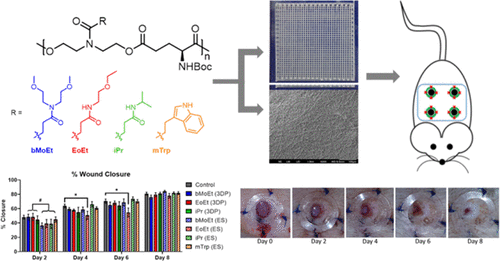当前位置:
X-MOL 学术
›
Biomacromolecules
›
论文详情
Our official English website, www.x-mol.net, welcomes your
feedback! (Note: you will need to create a separate account there.)
Thread Size and Polymer Composition of 3D Printed and Electrospun Wound Dressings Affect Wound Healing Outcomes in an Excisional Wound Rat Model.
Biomacromolecules ( IF 5.5 ) Pub Date : 2020-09-09 , DOI: 10.1021/acs.biomac.0c00801 Nicholas Nun 1 , Megan Cruz 1 , Tanmay Jain 1 , Yen-Ming Tseng 1 , Josh Menefee 1 , Samreen Jatana 2 , Pritam S Patil 3 , Nic D Leipzig 3 , Christine McDonald 2 , Edward Maytin 4, 5 , Abraham Joy 1
Biomacromolecules ( IF 5.5 ) Pub Date : 2020-09-09 , DOI: 10.1021/acs.biomac.0c00801 Nicholas Nun 1 , Megan Cruz 1 , Tanmay Jain 1 , Yen-Ming Tseng 1 , Josh Menefee 1 , Samreen Jatana 2 , Pritam S Patil 3 , Nic D Leipzig 3 , Christine McDonald 2 , Edward Maytin 4, 5 , Abraham Joy 1
Affiliation

|
Thread size and polymer composition are critical properties to consider for achieving a positive healing outcome with a wound dressing. Three-dimensional (3D) printed scaffolds and electrospun mats both offer distinct advantages as replaceable wound dressings. This research aims to determine if the thread size and polymer compositions of the scaffolds affect skin wound healing outcomes, an aspect that has not been adequately explored. Using a modular polymer platform, four polyester direct-write 3D printed scaffolds and electrospun mats were fabricated into wound dressings. The dressings were applied to splinted, full thickness skin wounds in an excisional wound rat model and evaluated against control wounds to which no dressing was applied. Wound closure rates and reduction of the wound bed width were not affected by the thread size or polymer composition. However, epidermal thickness was larger in wounds treated with electrospun dressings and was slightly affected by the polymer composition. Two of the four tested polymer compositions lead to delayed reorganization of granulation tissues. Moreover, enhanced angiogenesis was seen in wounds treated with 3D printed dressings compared to those treated with electrospun dressings. The results from this study can be used to inform the choice of dressing architecture and polymer compositions to achieve positive wound healing outcomes.
中文翻译:

3D打印和电纺伤口敷料的螺纹尺寸和聚合物成分会影响外伤大鼠模型的伤口愈合结果。
线径和聚合物组成是考虑用伤口敷料获得积极愈合结果的关键特性。三维(3D)打印支架和电纺垫都具有可更换伤口敷料的独特优势。这项研究旨在确定支架的线径和聚合物成分是否会影响皮肤伤口的愈合结果,这一方面尚未得到充分研究。使用模块化聚合物平台,将四个聚酯直写3D打印支架和电纺垫制成伤口敷料。将该敷料施用到切除伤口大鼠模型中的夹板,全层皮肤伤口上,并对照未施用敷料的对照伤口进行评估。伤口闭合率和伤口床宽度的减小不受线尺寸或聚合物组成的影响。然而,在用电纺敷料处理的伤口中表皮厚度较大,并且受聚合物组成的影响较小。四种测试的聚合物组合物中的两种导致肉芽组织的重组延迟。此外,与使用电纺敷料处理的伤口相比,在使用3D打印敷料处理的伤口中观察到增强的血管生成。这项研究的结果可用于告知敷料结构和聚合物成分的选择,以实现积极的伤口愈合效果。四种测试的聚合物组合物中的两种导致肉芽组织的重组延迟。此外,与电纺敷料相比,在3D打印敷料治疗的伤口中血管生成增强。这项研究的结果可用于告知敷料结构和聚合物成分的选择,以实现积极的伤口愈合效果。四种测试的聚合物组合物中的两种导致肉芽组织的重组延迟。此外,与电纺敷料相比,在3D打印敷料治疗的伤口中血管生成增强。这项研究的结果可用于告知敷料结构和聚合物成分的选择,以实现积极的伤口愈合效果。
更新日期:2020-10-12
中文翻译:

3D打印和电纺伤口敷料的螺纹尺寸和聚合物成分会影响外伤大鼠模型的伤口愈合结果。
线径和聚合物组成是考虑用伤口敷料获得积极愈合结果的关键特性。三维(3D)打印支架和电纺垫都具有可更换伤口敷料的独特优势。这项研究旨在确定支架的线径和聚合物成分是否会影响皮肤伤口的愈合结果,这一方面尚未得到充分研究。使用模块化聚合物平台,将四个聚酯直写3D打印支架和电纺垫制成伤口敷料。将该敷料施用到切除伤口大鼠模型中的夹板,全层皮肤伤口上,并对照未施用敷料的对照伤口进行评估。伤口闭合率和伤口床宽度的减小不受线尺寸或聚合物组成的影响。然而,在用电纺敷料处理的伤口中表皮厚度较大,并且受聚合物组成的影响较小。四种测试的聚合物组合物中的两种导致肉芽组织的重组延迟。此外,与使用电纺敷料处理的伤口相比,在使用3D打印敷料处理的伤口中观察到增强的血管生成。这项研究的结果可用于告知敷料结构和聚合物成分的选择,以实现积极的伤口愈合效果。四种测试的聚合物组合物中的两种导致肉芽组织的重组延迟。此外,与电纺敷料相比,在3D打印敷料治疗的伤口中血管生成增强。这项研究的结果可用于告知敷料结构和聚合物成分的选择,以实现积极的伤口愈合效果。四种测试的聚合物组合物中的两种导致肉芽组织的重组延迟。此外,与电纺敷料相比,在3D打印敷料治疗的伤口中血管生成增强。这项研究的结果可用于告知敷料结构和聚合物成分的选择,以实现积极的伤口愈合效果。











































 京公网安备 11010802027423号
京公网安备 11010802027423号